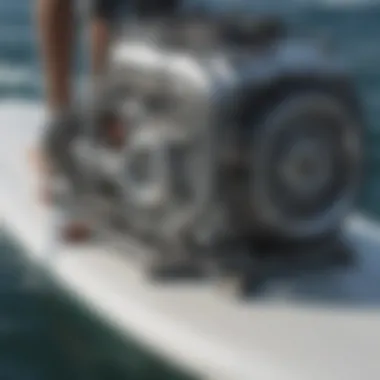Exploring Gas-Powered Motorized Surfboards Effectively


Intro
When it comes to riding waves, traditional surfboards have set the stage for decades. However, the advent of gas-powered motorized surfboards is turning heads and reshaping the way we interact with the ocean. These cutting-edge boards promise to enhance the thrill of surfing, combining the rush of speed with the serene enjoyment of gliding over water. But what exactly is behind this technological marvel?
In this article, we’ll navigate through the inner workings of gas-powered surfboards, exploring their mechanics, advantages, and downsides. Packed with details, this guide aims to equip both seasoned surfers and curious newcomers with extensive insight, ensuring you’re well-informed before heading out to catch waves. How do these boards work? What are the safety implications? And what does the future hold for motorized surfing? Let’s dive in.
Understanding Motorized Surfboards
Motorized surfboards are quickly turning heads in the watersport community. Understanding them isn't just for tech enthusiasts or those aiming to catch the latest wave of innovation. It's crucial for anyone who wants to merge creativity with oceanic adrenaline. When you grasp the intricacies of how motorized surfboards operate, you gain insights into their benefits, disadvantages, and how they stack up against traditional surfing methods.
The world of motorized surfboarding can shift how surfers, instructors, and outdoor enthusiasts view the ocean. The various options available provide gamers, thrill-seekers, and casual beach-goers with adaptable choices that suit different skill levels and conditions. Understanding the various types and mechanisms behind these boards helps create informed consumers in a crowded market. In a nutshell, this knowledge can greatly affect your experience on the water.
Definition and Purpose
Motorized surfboards combine the thrill of surfing with the ease and power of technology. These boards are built to enhance the surfing experience, unleashing riders into new realms of speed and adventure. The very purpose of a motorized surfboard is to lift the limitations of traditional surfing. No longer are you restricted to where the waves break. With a motor, users can traverse quieter waters, lakes, or even rivers. A unique blend of sport and technology, motorized surfboards are all about redefining the parameters of surfing.
Types of Motorization
Motorization in surfboards mainly comes down to either electric or gas-powered engines—and then there's the hybrid model, which merges the two concepts into one. So, what does that mean in practice?
Electric vs. Gas-Powered
Electric motorized surfboards are popular for their quieter operation and eco-friendly aspects. These boards tend to use rechargeable lithium-ion batteries, making them a hit among environmentally-conscious surfers. While they are often slower than their gas counterparts, they have a significant advantage in tranquility and ease of use. You can ride them in a more serene setting without stirring up too much fuss in the water.
Gas-powered boards, on the flip side, promise exhilarating speeds and longer ranges, thanks to their combustion engines. These engines can provide that adrenaline rush that many thrill-seekers crave. However, they come with their own downsides, such as noise and pollution. The trade-offs between the electric and gas options often depend on the rider's priorities—whether that's speed, eco-consciousness, or noise.
Key characteristics of both types include:
- Electric Boards:
- Gas-Powered Boards:
- Advantages: Quiet operation, eco-friendly, smoother acceleration.
- Disadvantages: Limited range and speed compared to gas.
- Advantages: High speeds, long range, robust engine performance.
- Disadvantages: Noisy operation, heavier, environmental concerns.
Hybrid Models
Hybrid models are a middle ground that showcases how amalgamation can be effective. These boards typically combine an electric motor and a gas engine. The aim is to utilize the best of both worlds. Riders experience both the raw power of gas and the quiet efficiency of electric, making hybrid models quite appealing for versatility seekers.
The unique feature of hybrid models is the ability to switch between power modes. When the waves are flattering, one could use the electric motor for a peaceful glide. When speed is desirable, they can easily transition to the gas engine.
This adaptability is a key characteristic that benefits riders who want a board for all occasions. However, hybrid models tend to be heavier, which can affect maneuverability. It’s a balancing act between power and ease of handling.
Gas-Powered Motorized Surfboards
Gas-powered motorized surfboards have been gaining traction in recent years, reshaping the way enthusiasts engage with the ocean. These boards not only provide excitement but also offer unique benefits that cater to various skill levels and surfing environments. This section zooms into the mechanics and performance metrics of gas-powered surfboards, giving readers a rounded perspective on their importance in the surfing world.
Mechanics of Gas-Powered Surfboards
Understanding the mechanics is crucial for anyone considering diving into the world of gas-powered surfboards. It's the backbone of how these boards operate and the features that make them stand out.
Engine Types
When it comes to engine types, we generally see two categories: two-stroke and four-stroke engines. Two-stroke engines are known for their lightweight and compact design, making them a popular choice among thrill-seekers who value speed. On the other hand, four-stroke engines provide a calmer riding experience, often producing less noise and emissions. The choice of engine can greatly influence the surfing experience, as those who highlight speed will likely lean towards the two-stroke for its acceleration.
One remarkable feature of these engine types is their ability to adapt to different surfing conditions. Two-stroke engines offer those sudden bursts of speed that can make a ride unforgettable, while four-stroke engines excel in calmer waters, providing a smoother glide. Both types come with their perks and pains, so understanding their unique characteristics will enhance one’s experience.
Fuel System Mechanics
Fuel systems in gas-powered surfboards are generally straightforward, consisting of a simple carburetor in most designs. This mechanism is central to how these surfboards operate. The carburetor draws a mix of air and fuel and delivers it to the engine, ensuring the right balance for optimal performance. This direct approach is advantageous as it enables quicker response times while accelerating.
However, one must also consider the downside. Regular maintenance is essential for keeping these systems functioning well, which can mean extra costs and effort. Specifically, sometimes debris can clog the lines, causing frustrating mid-ride stops. Consequently, understanding the fuel system mechanics will allow surfers to preemptively address common issues.
Performance Metrics
Gas-powered surfboards are not only defined by their mechanics, but also by their performance metrics. Speed and maneuverability are two significant factors that surfers often examine before making an investment.


Speed and Maneuverability
Speed is one of the standout features of gas-powered boards. Many models can easily hit speeds of over 30 mph. This rapid pace is a hallmark trait for enthusiasts looking for high-octane thrills on the water. The ability to maneuver quickly allows surfers to navigate through waves more effortlessly, giving them an edge when tackling tougher surf conditions.
However, this speed can also come with a learning curve. Newer riders may find high speeds intimidating or challenging to control. Maneuverability plays a big role here—boards that offer a tighter turning radius can make all the difference during those intense wave encounters. In sum, understanding the balance of speed and maneuverability will benefit those ready to tackle the waters.
Range and Endurance
Range and endurance are critical measures for anyone planning an extended outing. Gas-powered surfboards typically provide a longer range than their electric counterparts, making them appealing for those who wish to spend more time on the water rather than frequently recharging battery packs. Depending on tank size and engine efficiency, these boards can cover significant distances, often upwards of 30 miles.
This feature allows surfers to explore beyond the typical spots—think remote beaches or pristine coves that are otherwise difficult to reach. However, potential buyers should be cautious as some boards may consume fuel at alarming rates, drastically cutting down on their effective range. Therefore, the balance between performance and mileage is vital for a truly enjoyable experience.
Advantages of Gas-Powered Surfboards
Exploring the advantages of gas-powered surfboards offers insight into why many enthusiasts choose these boards over their electric counterparts. Given the unique capabilities that come with gas motorization, it’s clear how these boards can significantly enhance the overall surfing experience. Understanding the practical benefits is essential for those aiming to make informed decisions about their watercraft.
Increased Speed and Efficiency
One of the primary draws of gas-powered surfboards is their unmatched speed. Unlike electric models, which can be limited by battery life and output, gas-powered surfboards pack a punch. These boards typically reach higher top speeds, allowing riders to experience the rush of cutting through waves with ease. For thrill-seekers, this element of speed is a massive attraction.
Moreover, gas engines tend to maintain their performance over various distances. Riders won't need to constantly monitor a battery percentage, as they would with electric boards. Instead, they can enjoy extended time on the water without the nagging worry of running out of juice. This endurance can be particularly appealing during long sessions or when exploring larger bodies of water.
But the efficiency doesn't just stop at performance. These boards often consume fuel in a more efficient way compared to the energy expenditure of electric motors, making them a compelling option for those who plan to spend hours surfing. As the mechanics of gas engines have evolved, many models now offer better fuel economy, striking a balance between speed and sustainability.
Suitable for Various Conditions
Gas-powered surfboards shine in their versatility across different water conditions. Whether you're tackling choppy waves or gliding over calmer seas, these boards often handle beautifully. The powerful engine allows surfers to maintain stability regardless of how unpredictable the sea may become.
In challenging situations like rough surf or high winds, the extra power can keep riders in control and responsive to obstacles in their path. Even when conditions are less than ideal, gas-powered boards typically hold their own, which is a significant advantage for those who are often at the mercy of the wind and tide.
Additionally, since gas-powered surfboards are generally heavier, they can offer a lower center of gravity. This makes them more forgiving and manageable compared to lighter models. Surfers can push the limits, experiment with advanced maneuvers, and still feel confident that their surfboard can support them.
"Gas-powered boards take riding waves to a level that electric ones simply can't match, with speed and adaptability they bring the thrill of surfboarding to a new direction."
On top of it all, the convenience of fueling up before hitting the waves can’t be overlooked. Riders need not worry about finding an outlet or managing battery packs—just fill up the tank and go. This means more time enjoying the surf and less time fussing with equipment.
In summary, choosing a gas-powered surfboard can unlock a new level of excitement on the water, enabling riders to embrace speed and tackle a variety of surfing conditions with confidence.
Challenges and Disadvantages
When it comes to gas-powered motorized surfboards, while the excitement is palpable, there’s also a fair share of potential downsides that must be taken into account. Understanding the challenges and disadvantages associated with these boards is crucial for anyone looking to take the plunge into this new wave of surfing technology.
Notably, addressing these topics not only guides enthusiasts in making informed choices, but it also shines a light on the realities of using motorized equipment in natural settings.
Weight and Bulkiness
One of the primary hurdles with gas-powered motorized surfboards is their weight and bulkiness. Unlike traditional surfboards, which can be easily maneuvered and transported, gas-powered variants often bring extra heft due to their engines and fuel systems. This leads to several notable complications.
Carrying a board that can exceed the weight of typical surfboards by a significant margin can be less than convenient. Getting it from the car to the water? May feel like you’re dragging some hefty baggage. Plus, the bulky structure can sometimes hinder the balance and responsiveness that surfers often crave.
Moreover, consider the storage issues. Finding a proper place at home or in your vehicle to keep a sizable motorized surfboard isn’t always easy. So, while the thrill of high-speed rides beckons, the practicality of everyday use presents a challenge worth examining.
Maintenance and Costs
Then there's maintenance and costs, two capricious companions in the realm of motorized surfboards. First off, gas-powered boards can require significant upkeep due to their mechanical components. Unlike their electric counterparts that often involve less wear and tear, gas engines demand regular maintenance to keep things ticking smoothly.
You might find yourself needing to check oil levels, replace spark plugs, and conduct routine cleaning helpkeep on the operation at tip-top shape. These tasks can quickly add up, impacting your overall enjoyment. Cost-wise, the initial investment for quality gas-powered models can be steep. On top of that, ongoing fuel and maintenance costs can stretch your budget thinner than a gnat’s eyelid if one isn’t careful.
Environmental Impact
Gas-powered surfboards come with environmental implications that can't be ignored. Let's delve into a couple of key concerns surrounding this topic.
Pollution Concerns
Pollution is a pressing issue. Gas engines produce emissions that contribute to air and water pollution. When waves splash, the remnants of spilled fuel can migrate into the waters, affecting marine life. These pollution concerns don't merely pose risks to ecosystems; they can also impact the very experience that surfers seek. There's nothing quite like the serene beauty of nature, and introducing pollutants can diminish this enjoyment. Gas-powered surfboards may spoil pristine environments if not managed with care, which is a pressing dilemma for surfers seeking harmony with nature.
Sustainability Issues


Sustainability is another vital aspect. Relying on gas as a power source carries with it the question of renewable versus non-renewable energy. With fossil fuel extraction contributing to environmental degradation, the sustainability of gas-powered surfboards hangs in a precarious balance. The margins for maneuvering between enjoying high-speed rides and being a responsible steward for the environment can feel razor-thin.
Additionally, there’s pressure to refocus the surfboard industry on more sustainable practices, and as gas-powered boards grow in popularity, these ideas will likely prompt urgent discussions among manufacturers, surfers, and environmentalists alike.
In summary, while gas-powered surfboards offer a thrilling surf experience, these challenges remind enthusiasts to consider their choices carefully. They don’t just impact personal enjoyment– but they also play a role in broader conversations about sustainability and maintaining the delicate balance of our ecosystems.
Safety Considerations
When it comes to riding gas-powered motorized surfboards, prioritizing safety is as essential as knowing how to ride one. These powerful machines can offer thrilling experiences, but they also come with their own set of hazards. Understanding safety considerations is crucial for anyone looking to enjoy their time on the water without putting themselves or others at risk.
Safety tips can help prevent accidents and enable surfers to fully enjoy their activity while minimizing dangers, making it imperative to familiarize oneself with proper guidelines and necessary precautions.
Required Safety Gear
Before hitting the waves on a gas-powered surfboard, athletes should equip themselves with proper safety gear. It's not about looking stylish; it could mean the difference between a safe ride and a serious injury. Here’s a look at what one should consider wearing:
- Life Jacket: An essential piece for anyone venturing out on the water, a life jacket can save lives. Choose one that fits snugly but allows for movement.
- Helmet: Protecting your noggin is vital. Look for a helmet specifically designed for water sports, as they often have additional buoyancy and impact features.
- Impact Vest: This provides an added layer of protection against falls and collisions. It can absorb shocks effectively and help keep you afloat.
- Wetsuit or Rash Guard: Not only do they provide comfort against cold water, but they also offer protection from sunburn and scrapes.
- Footwear: Non-slip aquatic shoes can be quite handy. They ensure a good grip and protect your feet from sharp objects in the water.
By investing in adequate gear, riders are not just complying with safety protocols; they are also enhancing their surfing experience. Here, it is clear that wearing proper safety gear isn't just a precaution, it's a commitment to safeguarding oneself against possible accidents.
Operating Guidelines
Navigating a gas-powered surfboard requires more than just throttle control. Proper operating guidelines ensure that riding remains fun and safe. Here are some practices that should always be kept in mind:
- Know the Water Conditions: Before venturing out, take a moment to assess the current conditions. Check for wave height, wind speed, and potential hazards such as rocks or excessive boat traffic.
- Practice in Controlled Environments: For beginners, it’s best to practice in calm waters with little to no waves. This can build confidence and enhance control.
- Stay Aware of Your Surroundings: Keeping an eye on nearby surfers, swimmers, and marine vessels is crucial. Collisions can be serious, so having a good spatial awareness is vital for safety.
- Ride at Controlled Speeds: Although the thrill of speed can be tempting, going too fast can lead to loss of control. Maintain a safe speed, especially if you’re near others.
- Take a Safety Course: Investing time in a safety course can provide useful insights into safe operating practices and emergency maneuvers.
Following these guidelines will not only foster safety but also nurture a respectful and enjoyable surfing community.
Emphasizing safety while using gas-powered motorized surfboards should be non-negotiable for any adventurous surfer. It creates not only a better experience for the individual but also promotes the continuation of the sport for future enthusiasts.
Technological Innovations
In the bustling world of motorized surfboards, technological innovations play a significant role, influencing not just how surfers experience the waves but also enhancing performance and safety. Understanding these advancements can help surfers, instructors, beach lifeguards, and even outdoor writers appreciate the nuanced benefits brought forth by cutting-edge engineering. As the gas-powered motorized surfboard evolves, users are granted unprecedented access to features that optimize their surfing experience.
Advancements in Engine Technology
The heart of any motorized surfboard lies in its engine. Over the years, advancements in engine technology have turned traditional gas-powered motors into finely tuned machines focused on performance and efficiency. Manufacturers have invested heavily in research to create lightweight engines that pack a powerful punch, allowing surfers to soar across water with newfound agility. Newer engines are increasingly designed for improved fuel efficiency, which reduces overall costs during extended outings.
The shift toward utilizing advanced materials and innovative designs has resulted in engines that are not just more robust, but also more durable, decreasing the likelihood of breakdowns during use. An added bonus is the quieter operation of contemporary engines. This not only creates a more enjoyable experience for the rider but also minimizes disturbances to marine life. The integration of technology like electronic fuel injection (EFI) has further optimized engine performance, providing riders with seamless acceleration and improved throttle response.
"Engine technology has progressed remarkably, transforming an exhilarating sport into a more sustainable and enjoyable experience for many!"
Integration of Navigation Systems
Navigating the open water with a gas-powered motorized surfboard has never been easier, thanks to sophisticated navigation systems. These systems often feature GPS capabilities, enabling riders to track their routes, speed, and even overall performance metrics. For surfers who crave exploration, having a built-in navigation system eliminates guesswork, allowing them to venture confidently into uncharted waters.
Moreover, some advanced models include touch-screen interfaces that provide real-time updates on water conditions and obstacles. Riders can quickly find the best spots to surf simply by glancing at the screen. These features not only enhance the overall experience but also bolster safety, as it allows users to maintain awareness of their surroundings.
As outdoor writers and marine biologists alike might note, such innovations represent a leap forward in integrating technology with nature. This combination brings about a new culture in motorized surfing—one that embraces the thrill while being mindful of safety and environmental impacts. The focus on improving navigation reflects a broader trend of ensuring that motorized surfing complements the natural beauty of ocean settings rather than diminishes them.
Regulations and Compliance
Navigating the waters of gas-powered motorized surfboards isn't just about mastering the waves; it’s also about understanding the rules that govern their use. Regulations and compliance are crucial to ensuring safety, protecting the environment, and upholding the integrity of marine activities. It’s essential for surfers, manufacturers, and enthusiasts alike to grasp these legal frameworks because they dictate what’s permissible and what could lead to penalties or risks.
For those venturing into motorized surfing, awareness of local laws and restrictions can prevent a sour experience. These regulations not only vary from one region to another but can also change with time. Surfing communities are often intertwined with conservation efforts and local customs, making it even more critical to stay informed.
Local Laws and Restrictions
In many areas, local stipulations dictate where motorized surfboards can be ridden. For instance, some beaches may prohibit their use altogether, while others could restrict usage to certain times of day or specific zones. Knowing these regulations helps avoid fines and encourages responsible surfing.
Some important factors to consider include:
- Speed Limits: Local ordinances might set maximum speed limits for safety, especially near crowded areas.
- Restricted Areas: Look for signs indicating no-entry zones for gas-powered surfboards, such as swimming areas or marine preserves.
- Environmental Considerations: Many regions implement rules to protect wildlife, requiring motorized boards to stay clear of sensitive habitats.
As an example, the California Coastal Commission often issues guidelines on how to use motorized surfboards to minimize potential disruption to marine ecosystems. Knowing these nuances can aid surfers in aligning with the local surfing culture.
Licensing Requirements
Operating a gas-powered motorized surfboard may come with specific licensing demands. Just like you wouldn't get behind the wheel of a car without a license, it's wise to research whether a similar approach applies to motorized surfing.


Some areas require users to obtain special permits or registrations. This can involve steps like undergoing safety training or passing competency tests. Here are some points to be aware of:
- Permit Applications: Check if you need to process a permit application specific to operating motorized surfboards.
- Safety Courses: Completing a certified safety course can sometimes be a prerequisite, emphasizing responsible handling of the equipment.
- Age Limitations: Regions might impose age restrictions requiring operators to be of a certain age, often in line with local boating regulations.
Important Note: It's crucial to understand that non-compliance can result in hefty fines or even the confiscation of equipment.
In summary, by keeping an eye on regulations and requirements, enthusiasts can enjoy motorized surfing within safe and legal boundaries, while also contributing positively to the beach-going experience. Always ensure to check local resources or community guidelines specific to your surf spots to stay well-informed.
Future of Motorized Surfboards
As the world of water sports evolves, gas-powered motorized surfboards are making quite a splash. Understanding their future is essential, not just for enthusiasts but also for manufacturers, safety regulators, and environmental advocates. The trends, innovations, and shifts in public perception have profound implications for both the surf industry and recreational users.
Market Trends and Projections
The market for motorized surfboards has seen a surge in interest, and projections suggest this trend won't be fizzling out anytime soon. One significant trend is the growing popularity of personalized designs. More surfers are looking for boards that reflect their unique style and preferences. This demand for customization could lead manufacturers to innovate beyond basic practicality, embracing design elements reminiscent of traditional surfboards while integrating motorization functionality.
Moreover, the youth demographic is increasingly attracted to adventure sports, adding to the market's popularity. While surfing has remained popular for decades, the allure of motorized options adds a new layer of excitement. As reported by some industry insiders, youth culture’s shifting towards more extreme sports means a greater receptivity to technologies that enhance performance on the water.
There's also an increasing focus on eco-friendliness. With environmental impact at the forefront of public consciousness, consumers are leaning towards models that prioritize sustainability. Gas-powered boards must evolve to address green technologies or face a declining market presence. This pressure will undoubtedly lead to more manufacturers exploring eco-friendly materials and cleaner fuel options. In the long run, boards that strike a balance between performance and environmental responsibility could dominate the market.
"The future will demand innovation and responsibility. Shoppers want to enjoy the thrill while being mindful of nature."
Potential Innovations and Design Evolution
Innovations extend beyond mere cosmetic change; they spark fundamental rethinking of technical standards. Gas-powered surfboards are likely to witness advancements in engine efficacy. As manufacturers strive for better power-to-weight ratios, this could mean smaller, lighter engines that don’t compromise performance. Engineers are already experimenting with materials like carbon fiber to enhance strength without adding heft, ensuring that surfboards remain agile on the water.
Moreover, the integration of smart technology is on the horizon. Imagine a surfboard that can connect to GPS-based navigation systems, offering speeds and routes akin to automotive GPS devices. Additional features might include performance tracking, collision avoidance systems, and more sophisticated fuel management, ensuring that riders are safer on the water.
As designs evolve, augmented reality (AR) might also play a significant role, providing users with real-time data about their environment, including tides, wind conditions, and equipment performance. This melding of traditional surf culture with cutting-edge tech can create a whole new experience for riders. While innovation has immense potential to enhance performance, it must embrace the spirit of the surf culture—freedom, connection to nature, and communal enjoyment.
Community and Culture
The interplay between technology and the traditional surfing community is a topic of growing importance as gas-powered motorized surfboards carve out their niche in the surf culture. Understanding this aspect is essential for anyone keen on the topic, as it highlights not just how motorized boards work, but also their significant effects on the community surrounding water sports. The dialogue that emerges from integrating gas-powered boards into this space delves into identity, culture, and the evolution of a sport that continues to widen its horizon.
The Rise of Motorized Surfing
Motorized surfing is not just an extension of the sport; it represents a new wave of enthusiasts joining the ranks. This rise can be attributed to various factors: advancements in technology, accessibility of boards, and an increasing appetite for thrill-seeking experiences. Gas-powered surfboards have certainly seized the attention of many, allowing users to glide effortlessly over waves without depending solely on physical prowess or ideal conditions. It’s almost like trading in a bicycle for a motorcycle; the thrill factor gets ramped up significantly.
In recent years, social media has played a crucial role in the proliferation of motorized surfing. Users showcase their experiences on platforms like Facebook and Reddit, crafting videos that embody the excitement and enjoyment gas-powered surfboards deliver. This new visual culture serves as a powerful marketing tool, encouraging others to jump in and try their hand at this exhilarating form of surfing. As more riders share their journeys, curiosity breeds interest, forming a vibrant community around motorized surfing.
Despite its rising popularity, the division between traditional surf culture and motorized surfing has sparked debates. Proponents argue that it expands the recreational possibilities of surfing, enabling people who might not have the stamina or experience to surf otherwise to join in on the fun. Conversely, some traditionalists bemoan the diminishing purity of surfing, asserting that the essence of riding waves has become tainted when powered by an engine.
Impact on Traditional Surf Culture
The introduction and acceptance of gas-powered surfboards inevitably have had a profound impact on traditional surf culture. While some surfers embrace the innovation as a means to explore new ways of riding waves, others feel it compromises the sport's authenticity.
- Diversity of Experiences: With the addition of motorized boards, surfers can experience new forms of entertainment on the water. Waves can be tackled in a different manner, allowing for exploration in areas that might not be accessible with traditional boards.
- Environmental Concerns: On the flip side, this new wave of surfing brings attention to environmental issues. For those in favor of traditional surfing, the fuel emissions from gas-powered boards can be a sore point. They argue that the heart of surfing—engaging with nature—is compromised when machines interfere with the natural environment.
- Inclusive Community: Motorized surfboards have the potential to democratize the sport. More individuals, regardless of skill or energy levels, can partake in water activities. As the landscape of surfing expands, so does the community, bringing together people from different walks of life who might find common ground in the thrill of riding.
Some surfers even find ways to blend both worlds, opting for a hybrid approach to surf with gas-powered boards while maintaining an appreciation for the traditional craft. As communities continue to adapt and evolve, discussions surrounding identity, values, and practices in surfing culture remain ever-present.
"The surf community is resilient, constantly shifting as it embraces change while holding onto cherished traditions."
As the use of gas-powered surfboards becomes more widespread, the dialogue surrounding their impact on traditional surfing will undoubtedly continue to shape the culture, influencing everything from local surf competitions to casual beach get-togethers. The fusion of old and new may transform the landscape of surfing, but one thing's for sure: the sea will always remain a powerful force, inviting all to join in its dance.
Closure
In summation, the exploration of gas-powered motorized surfboards proves to be a significant dive into modern water sports. This article examined a variety of aspects related to these dramatic innovations, revealing not only how they operate but also their broader implications for the surfing community and environment.
Summation of Key Points
Gas-powered motorized surfboards bring forth three main advantages:
- Enhanced Performance: Due to their robust engines, these boards typically boast greater speed and agility compared to their electric counterparts, making them suitable for a wider range of conditions.
- Versatile Usage: With the ability to traverse challenging waters or cruise leisurely along beaches, they cater to diverse user preferences and skill levels.
- Innovative Technology: Advances in engine efficiency and fuel management have made these boards increasingly more eco-conscious than in earlier generations.
On the flip side, we also addressed challenges such as maintenance costs, weight issues, and environmental considerations that may arise from their use. These factors are crucial for potential buyers to bear in mind as they navigate their options in the marketplace.
Final Thoughts on Motorized Surfboarding
Enthusiasts and professionals alike should take the time to ponder the role of gas-powered surfboards in shaping the future of outdoor water activities. They serve not just as a tool for recreation but as a bridge between traditional surf culture and a progressive approach towards using power for fun.
While they certainly provide thrilling experiences, the consequences associated with their operation—especially concerning the environment—should never be ignored.
As the surfing world progresses further, balancing exhilarating innovation with sustainability will be key for the community. If individuals can engage with these devices mindfully, then the impact may be significantly positive, aligning with both enjoyment and ecological considerations.















